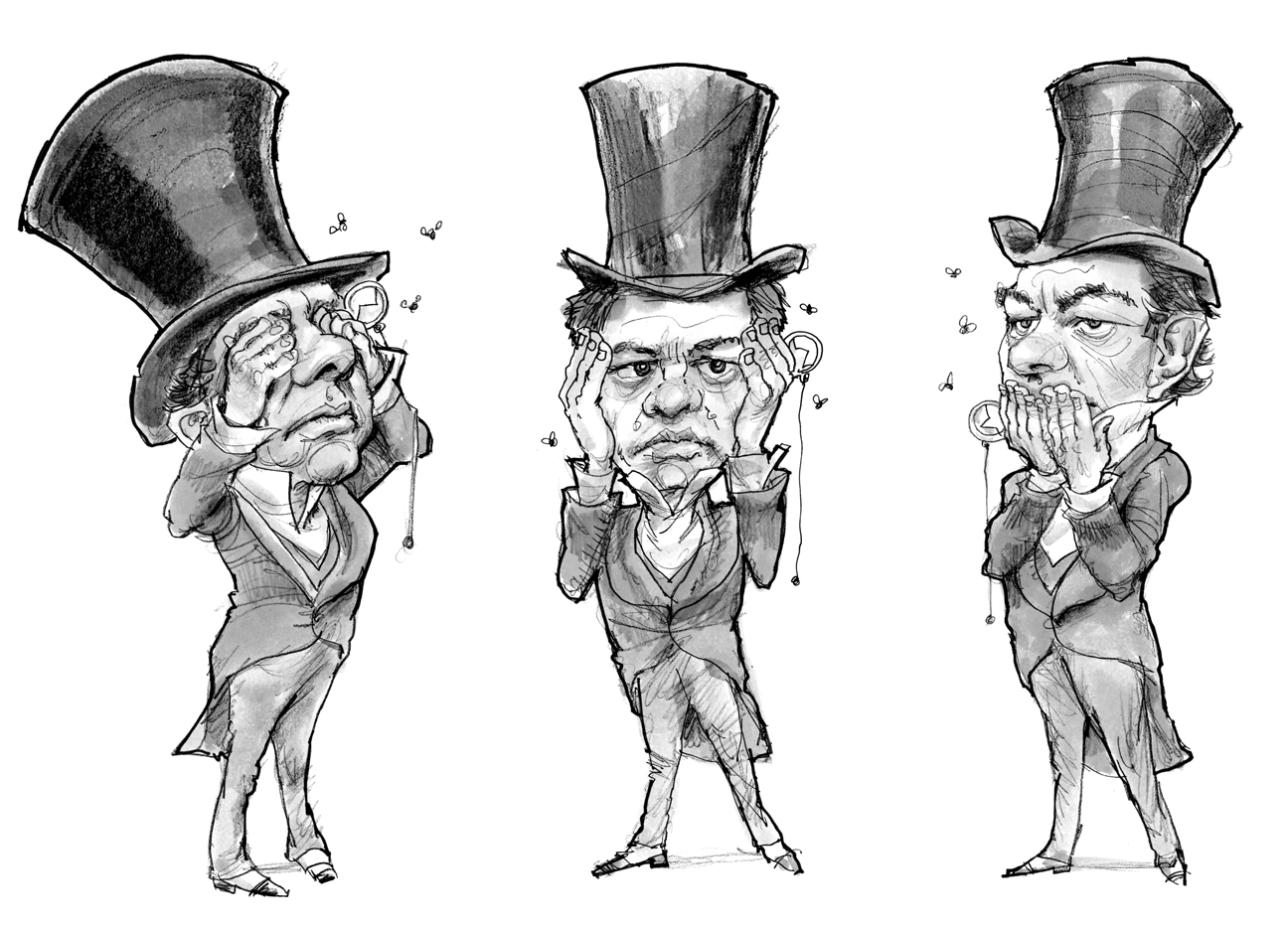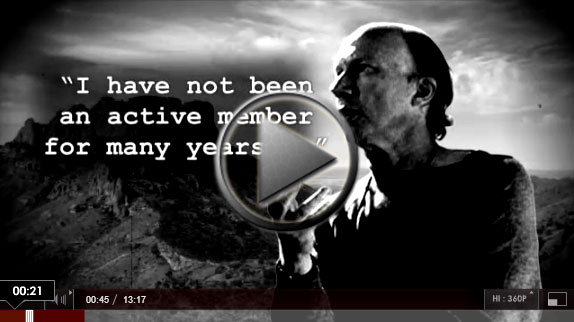The New Yorker: What a Load of Balderdash
 Prior to the Lawrence Wright-authored piece published in February 2011, The New Yorker had never written about filmmaker Paul Haggis. As a matter of fact, The New Yorker had even passed Haggis by in 2006 when he was in the sharp focus of Hollywood klieg lights. And what a story that might have been, given it was well known he took home an Oscar by default, riding a widely reported “anti-gay vote” over Brokeback Mountain. At the time, Los Angeles Times movie critic Kenneth Turan maintained that some Academy members displayed "discomfort" with the subject matter of Brokeback Mountain, which tells of a homosexual romance between two cowboys. The critic noted that these voters might have cast their ballots for Crash so they could still “feel like they were good, productive liberals.” Hence Crash's victory.
Prior to the Lawrence Wright-authored piece published in February 2011, The New Yorker had never written about filmmaker Paul Haggis. As a matter of fact, The New Yorker had even passed Haggis by in 2006 when he was in the sharp focus of Hollywood klieg lights. And what a story that might have been, given it was well known he took home an Oscar by default, riding a widely reported “anti-gay vote” over Brokeback Mountain. At the time, Los Angeles Times movie critic Kenneth Turan maintained that some Academy members displayed "discomfort" with the subject matter of Brokeback Mountain, which tells of a homosexual romance between two cowboys. The critic noted that these voters might have cast their ballots for Crash so they could still “feel like they were good, productive liberals.” Hence Crash's victory.
The rancor runs so deep concerning the Crash win, Entertainment Weekly’s 2011 Oscar coverage included an article entitled, “The Most Overrated Best Picture Winners Ever: And the Oscar goes to…WHAT? The ugly truth is that the best picture doesn’t always win Best Picture…” EW writer Chris Nashawaty wrote:
“Paul Haggis’s L.A. mosaic preaches to the choir, and in return, Left Coast Academy members could pat themselves on the back for handing over the big prize. We said it then: Brokeback Mountain should’ve won.”
Enter The New Yorker, suddenly tapping Haggis as the subject of their coveted “profile.” The article was to be written by staffer Wright and, as The New Yorker editor, David Remnick, told Church officials:
“‘Profiles’ is a term that was invented by The New Yorker, which is why we use it in maybe prideful upper case. It’s an extensive rigorously reported piece on someone's life. We’ve been doing this for a very long time.”
This was not, to use Remnick’s words, an “extensive rigorously reported piece on someone’s life”; nor was it simply “a story on Scientology”—it was an anti-religion piece seen only through the eyes of an apostate.
Never mind The New Yorker-brand arrogance, Remnick was clearly dissembling. For whatever pretense he and Wright had constructed, their true agenda was soon revealed from within their own ranks. It came in the form of an email to the Church from Melissa Goldstein in the photo department: “The New Yorker is doing a piece on Scientology.”
She wasn’t the only magazine staffer who called the article what it truly was, as one email after another leaked with statements about Wright’s story “on Scientology.” Haggis’s name wasn’t mentioned because the profile was no longer—and had never been—about Haggis. Something which Remnick shamelessly confirmed only after the article was published in a recent Q&A with Canada's The Globe and Mail, wherein he describes the article as, “a 25,000-word piece on Scientology” with nary a mention of Haggis.
Apparently even Haggis claims he had initially been duped. He told a family member that when first sitting down with Wright he thought the “profile” was the result of his upcoming movie release. But Wright quickly disabused him, explaining that what he wanted was an in-depth interview about Scientology, adding: “Why else would The New Yorker want to interview you?”
No, this was not, to use Remnick’s words, an “extensive rigorously reported piece on someone’s life”; nor was it simply “a story on Scientology”—it was an anti-religion piece seen only through the eyes of an apostate.
Haggis had earned that status following his public disavowal of the Church some months earlier. In truth, he had gone out of his way to hide his membership for years and had not been active in the Church for better than three decades. All of which made his resignation much ado about nothing for everyone except, it would seem, Lawrence Wright and The New Yorker. (See the video The Many Personas of Paul Haggis and see A Freedom Profile of Paul Haggis: The Hypocrite of Hollywood.)
Haggis’s pretended “crisis of faith” was tied into the Internet fringe ramblings of a “Posse” of anti-Scientologists. They had recently launched a cottage industry pawning off fabricated allegations about the Church to the media. These apostates of the first order, including expelled former Church of Scientology staffers Marty Rathbun, Mike Rinder, Tom DeVocht and Amy Scobee, became Haggis’s best buddies and Wright’s less-than-authoritative sources.
That they were former staff members is key given they now obsess on the individual who removed them from their positions within the Church. Of course, within journalistic circles, using “formers” as sources is a chapter right out of The Investigative Reporter’s Handbook. As the authors note, “The formers often have scores to settle or outdated knowledge.” In fact, Wright’s embittered sources have both. And indeed, most have been gone from the Church five, ten, even more than 20 years and had no current information about Scientology.
The fact that “formers” act out of their need for self-justification and blame their former associates for their own misdeeds is another page from the “Apostate Primer.” In particular, the works of religious scholar and Oxford University professor, the late Bryan R. Wilson, Ph.D., who wrote, “As various instances have indicated, [the apostate] is likely to be suggestible and ready to enlarge or embellish his grievances to satisfy that species of journalist whose interest is more in sensational copy than in an objective statement of the truth.” That’s Rathbun, Rinder, DeVocht and Scobee, et al. to a “t”—not to mention apostate du jour Haggis.
Thus, at the hands of one of that “species of journalist,” the self-styled “publication of record” reduced itself to a supermarket tabloid by launching a tabloid-style attack on the Scientology religion.
It’s not as though Wright didn’t know the truth. The Church had provided him with volumes of information, including written statements from key sources in which they admitted to their lies and malfeasance. Moreover, these apostate statements were a matter of public record having long since been published online and in print. Also provided to The New Yorker were declarations sworn under oath from numerous outraged Church officials, refuting the untruths.
Wright simply ignored the overwhelming body of evidence because none of it suited the predetermined story that he and The New Yorker sought to publish.
Of course, a clue to Wright’s sympathy for the disaffected may stem from this autobiographic confession in which he describes his break from the Methodist religion: “I wasn't aware that these pessimistic thoughts of mine were part of the larger national impulse, a disillusionment with old values that would be characteristic of my generation. I only knew that in Dallas, Texas, in 1963, the voice inside me was the voice of apostasy…” So possibly the only thing Wright got right was use of the term “apostate.”
“… [The apostate] is likely to be suggestible and ready to enlarge or embellish his grievances to satisfy that species of journalist whose interest is more in sensational copy than in an objective statement of the truth.” That’s Rathbun, Rinder, DeVocht and Scobee, et al. to a “t”—not to mention apostate du jour
Haggis.
The true nature and tone of Wright’s piece was laid bare four months into the affair, as Wright finished his article when The New Yorker’s notorious “fact-checking” process began. While Wright was writing he had sent only three research inquiries in almost as many months. So, it came as a shock when, on August 25 and 26, an avalanche of 971 so-called “fact-check” questions landed in Church offices—with an eight-day deadline to reply. What was even more surprising was that 59 percent of the statements, assertions and questions he sent to “fact-check” were not factual at all. What were left included mundane details no one would question, such as verifying the title of Dianetics: The Modern Science of Mental Health, if it was authored by L. Ron Hubbard and when the Church of Scientology was founded, to name just a few.
If the story had been well-researched and written, it would be easy to confirm the accuracy of “facts” but, as Church officials worked around the clock researching and answering The New Yorker’s questions they found many inaccurate, if not arcane, dating back more than 60 years, some exposing sheer ignorance, and still more blatantly offensive—it became clear that Wright’s article was not adhering to The New Yorker's mission statement of "original reporting." Instead, the questions telegraphed the fact he was relying on a wellspring of flawed and false information gathered from the underbelly of the Internet, unverified wiki entries, and, naturally, the handful of apostates.
Church officials, along with Church counsel, traveled to Condé Nast’s New York headquarters to present 48 binders of documentation belying the preposterous nature of the questions. As a comment on Wright’s journalistic integrity or lack thereof, the Church demonstrated that 59 percent of the facts he was “checking” from his finished article were utterly and irrefutably false. At which point, more than half of Wright’s anti-Scientology prose bit the dust. Only then was The New Yorker convinced to take a hard look at the facts.
Or so it seemed. Because after months of silence from the magazine, while the printing presses were literally warming up, the Church was hit with another onslaught of wildly objectionable, one-sided, mostly inaccurate and entirely bigoted fact-check questions.
This was clearly an underhanded and deliberate part of The New Yorker process. For in the end it was all about ensuring that the “truth” Wright wanted to present would never be subjected to the scrutiny it deserved.
So we get an article with:
- A blatantly untrue accusation about the Church’s stance on gay rights. Wright ignored the fact that the Church never engages in any kind of election activities and cannot do so. Further, as a matter of policy, it rarely takes positions on legislation. Nor is it remotely a matter of faith, given the Creed of the Church makes clear that Scientology is open to all. Haggis knew this well and Wright ignored the facts even when they were in front of him in black and white.
- A litany of fabricated stories about the religion, its Founder and ecclesiastical leader emanating from a handful of long-discredited apostates. They shopped their stories to a few media outlets and hooked The New Yorker with their dizzyingly-changing stories. Wright never even looked despite having declarations, affidavits, documentary and video evidence as to the falsity of their claims.
- An apostate-corroborated fairy tale account of a pair of failed lawsuits instigated by a husband-and-wife apostate team. When a federal district court judge looked at the undisputed facts, including that both voluntarily joined Scientology’s religious order knowing the commitment of dedicated ministerial work, in none-too-blunt terms the judge dismissed both cases. The Church was awarded costs.
- An alleged “investigation” of the Church, suspiciously saved for the end of the article, yet tellingly placed at the top of The New Yorker press release. Wright committed that ultimate journalistic sin of sleaze, carefully crafting his story to imply the “investigation” was the afterlife of the aforementioned dead-in-the-water “his and hers” court cases. While it might have been a neat trick to garner headlines, The New Yorker ignored all the information the Church provided showing it wasn't true before it went to press. Even other serious media didn’t buy the story.
- A pack of unreliable and discredited sources. Not a minor point considering The New Yorker hides behind an air of journalistic arrogance. The Society of Professional Journalists’ Code of Ethics begins with the words, “Seek Truth and Report It.” The code exhorts against distortion and demands “the public is entitled to as much information as possible on sources’ reliability.” Wouldn’t that include disclosing three of Wright’s sources were involved in obstruction of justice and suborning perjury, among other go-to-jail criminal conduct?
- An apologist entry of the cyberterrorist group “Anonymous,” who Wright so casually calls “a ‘hacktivist’ collective.” Missing is the fact that Anonymous has issued death and kidnapping threats of Church leaders, as well as threatening Churches and parishioners with fake anthrax threats, bomb and arson threats, acts of vandalism on Churches of Scientology as well as web-based attacks that has two of their members doing hard time in federal penitentiaries. Anonymous not only continues to be subject to investigation by the U.S. Department of Justice Hate Crimes division and a joint task force of the FBI, U.S. Secret Service, U.S. Attorneys Office and various state law enforcement agencies, but recently FBI agents arrested 16 Anonymous members across the United States.
- Notably missing, not one fact about the Church today and all its ecclesiastical leader is doing to expand the religion: none of its newly opened Churches, nor the restoration of its Founder’s Scripture, nor the new state-of-the-art facilities for its propagation, nor its global humanitarian works. All available to Wright and all absent from the pages of The New Yorker. (Watch the video: How Lawrence Wright Got It So Wrong.)
All of which begs the question: Why did The New Yorker print anything from such a highly discredited and interlocking group of sources? (Watch the video: The New Yorker: Tabloid of Record.)

Clearly, it’s all about the money. Recently released single-copy sales figures revealed a 12-percent drop in just six months. Not to mention a consultant firm specializing in corporate downsizing is again roaming the halls of Condé Nast headquarters. With the article appearing in their heralded anniversary issue, sales were paramount—and their anti-Scientology piece was nothing more than a craven attempt to pimp up sales. And, money for Lawrence Wright, who said it best himself when talking to a group of journalism students about the article, “I get paid by the word. Of course, that's why the story was 25,000 words.” Thus, greed ruled the day, and The New Yorker went to press.
In the end, it was telling that Paul Haggis’s name wasn’t even on the cover flap of the magazine, nor was it in the table of contents.
Only one subject appeared on the cover, the subject Wright was attempting to defame from the start: the Church of Scientology.
Hence, the ruse of a Paul Haggis “profile” became the silver platter upon which Wright heaped lies, fabrications and false allegations until The New Yorker could barely contain the load of balderdash.
Page Type:


